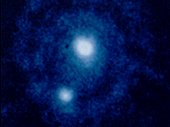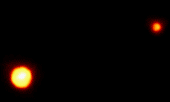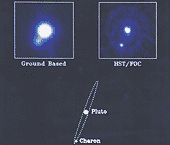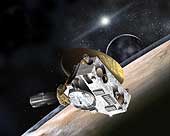|
Table of Contents |
|
Pluto Introduction
|
|
Pluto's Moons |
|
Pluto Science |
|
Other Resources |
|
|
Although Pluto was discovered in 1930, limited information on the distant object delayed a realistic understanding of its characteristics. Pluto is the second largest known dwarf planet and tenth largest orbiting the Sun. From its time of discovery in 1930 to 2006 it was considered to be the ninth planet in the solar system, but because additional objects have been discovered including Eris which is 27% more massive, the IAU reclassified Pluto and the other objects as dwarf planets. The New Horizons spacecraft was launched on January 16, 2006 and will make its closest approach to Pluto on July 14, 2015. This mission will provide an increased amount of information about this peculiar dwarf planet. The uniqueness of Pluto's orbit, rotational relationship with its satellite, spin axis, and light variations all give it a certain appeal.
Pluto is usually farther from the Sun than any of the eight planets; however, due to the eccentricity of its orbit, it is closer than Neptune for 20 years out of its 249 year orbit. Pluto crossed Neptune's orbit January 21, 1979, made its closest approach September 5, 1989, and remained within the orbit of Neptune until February 11, 1999. This will not occur again until September 2226.
As Pluto approaches perihelion it reaches its maximum distance from the ecliptic due to its 17-degree inclination. Thus, it is far above or below the plane of Neptune's orbit. Under these conditions, Pluto and Neptune will not collide and do not approach closer than 18 A.U. to one another.
Pluto's rotation period is 6.387 days, the same as its satellite Charon. Although it is common for a satellite to travel in a synchronous orbit with its planet, Pluto rotates synchronously with the orbit of its satellite. Thus being tidally locked, Pluto and Charon continuously face each other as they travel through space.
Unlike most planets, but similar to Uranus, Pluto rotates with its poles almost in its orbital plane. Pluto's rotational axis is tipped 122 degrees. When Pluto was first discovered, its relatively bright south polar region was the view seen from the Earth. Pluto appeared to grow dim as our viewpoint gradually shifted from nearly pole-on in 1954 to nearly equator-on in 1973. Pluto's equator is now the view seen from Earth.
During the period from 1985 through 1990, Earth was aligned with the orbit of Charon around Pluto such that an eclipse could be observed every Pluto day. This provided opportunity to collect significant data which led to albedo maps defining surface reflectivity, and to the first accurate determination of the sizes of Pluto and Charon, including all the numbers that could be calculated therefrom.
The first eclipses (mutual events) began blocking the north polar region. Later eclipses blocked the equatorial region, and final eclipses blocked Pluto's south polar region. By carefully measuring the brightness over time, it was possible to determine surface features. It was found that Pluto has a highly reflective south polar cap, a dimmer north polar cap, and both bright and dark features in the equatorial region. Pluto's geometric albedo is 0.49 to 0.66, which is much brighter than Charon. Charon's albedo ranges from 0.36 to 0.39.
The eclipses lasted as much as four hours and by carefully timing their beginning and ending, measurements for their diameters were taken. The diameters can also be measured directly to within about 1 percent by more recent images provided by the Hubble Space Telescope. These images resolve the objects to clearly show two separate disks. The improved optics allow us to measure Pluto's diameter as 2,274 kilometers (1413 miles) and Charon's diameter as 1,172 kilometers (728 miles), just over half the size of Pluto. Their average separation is 19,640 km (12,200 miles). That's roughly eight Pluto diameters.
Average separation and orbital period are used to calculate Pluto and Charon's masses. Pluto's mass is about 6.4 x 10-9 solar masses. This is close to 7 (was 12 x's) times the mass of Charon and approximately 0.0021 Earth mass, or a fifth of our moon.
Pluto's average density lies between 1.8 and 2.1 grams per cubic centimeter. It is concluded that Pluto is 50% to 75% rock mixed with ices. Charon's density is 1.2 to 1.3 g/cm3, indicating it contains little rock. The differences in density tell us that Pluto and Charon formed independently, although Charon's numbers derived from HST data are still being challenged by ground based observations. Pluto and Charon's origin remains in the realm of theory.
Pluto's icy surface is 98% nitrogen (N2). Methane (CH4) and traces of carbon monoxide (CO) are also present. The solid methane indicates that Pluto is colder than 70 Kelvin. Pluto's temperature varies widely during the course of its orbit since Pluto can be as close to the sun as 30 AU and as far away as 50 AU. There is a thin atmosphere that freezes and falls to the surface as the planet moves away from the Sun. The atmospheric pressure deduced for Pluto's surface is 1/100,000 that of Earth's surface pressure.
Pluto was officially labeled the ninth planet by the International Astronomical Union in 1930 and named for the Roman god of the underworld. It was the first and only planet to be discovered by an American, Clyde W. Tombaugh. It has since been reclassified as a Dwarf Planet along with Eris and Ceres.
The path toward its discovery is credited to Percival Lowell who founded the Lowell Observatory in Flagstaff, Arizona and funded three separate searches for "Planet X." Lowell made numerous unsuccessful calculations to find it, believing it could be detected from the effect it would have on Neptune's orbit. Dr. Vesto Slipher, the observatory director, hired Clyde Tombaugh for the third search and Clyde took sets of photographs of the plane of the solar system (ecliptic) one to two weeks apart and looked for anything that shifted against the backdrop of stars. This systematic approach was successful and Pluto was discovered by this young (born 4 Feb 1906) 24 year old Kansas lab assistant on February 18, 1930. Pluto is actually too small to be the "Planet X" Percival Lowell had hoped to find. Pluto's was a serendipitous discovery.
| Pluto Statistics | |
|---|---|
| Discovered by | Clyde W. Tombaugh |
| Date of discovery | February 18, 1930 |
| Mass (kg) | 1.27e+22 |
| Mass (Earth = 1) | 2.125e-03 |
| Equatorial radius (km) | 1,137 |
| Equatorial radius (Earth = 1) | 0.1783 |
| Mean density (gm/cm^3) | 2.05 |
| Mean distance from the Sun (km) | 5,913,520,000 |
| Mean distance from the Sun (Earth = 1)) | 39.5294 |
| Rotational period (days) | -6.3872 |
| Orbital period (years) | 248.54 |
| Mean orbital velocity (km/sec) | 4.74 |
| Orbital eccentricity | 0.2482 |
| Tilt of axis (degrees) | 122.52 |
| Orbital inclination (degrees) | 17.148 |
| Equatorial surface gravity (m/sec^2) | 0.4 |
| Equatorial escape velocity (km/sec) | 1.22 |
| Visual geometric albedo | 0.3 |
| Magnitude (Vo) | 15.12 |
| Atmospheric composition
Methane Nitrogen | 0.3 |
- Pluto, Charon, and USA Size Comparison.
- Pluto rotation movie.
- Pluto rotation movie.
- Charon rotation movie.
 Pluto & Charon
Pluto & Charon
This view of Pluto was taken by the Hubble Space Telescope. It shows a
rare image of tiny Pluto with its moon Charon, which is slightly
smaller than the planet. Because Pluto has not yet been visited by any
spacecraft, it remains a mysterious planet. Due to its great distance
from the sun, Pluto's surface is believed to reach temperatures as low
as -240°C (-400°F). From Pluto's surface, the Sun appears as
only a very bright star.
(Courtesy NASA)
 Dwarf Planets
Dwarf Planets
The following images represent the three newly designated dwarf planets. The
image of Pluto was rendered from a map created from a servies of Hubble images.
Eris is an artistic image, and Ceres is a Hubble telescope image.
(Copyright Calvin J. Hamilton)
 Hubble Telescope Image
Hubble Telescope Image
This is the clearest view yet of the distant planet Pluto and its moon,
Charon, as revealed by the Hubble Space Telescope (HST). The image was
taken on February 21, 1994, when the planet was 4.4 billion kilometers
(2.7 billion miles) from the Earth.
The HST corrected optics show the two objects as clearly separate and sharp disks. This now allows astronomers to measure directly (to within about 1 percent) Pluto's diameter of 2,320 kilometers (1,440 miles) and Charon's diameter of 1,270 kilometers (790 miles).
The HST observations show that Charon is bluer than Pluto. This means
that the worlds have different surface composition and structure. A
bright highlight on Pluto indicates that it might have a smoothly
reflecting surface layer. A detailed analysis of the HST image also
suggests that there is a bright area parallel to the equator of Pluto.
However, subsequent observations are needed to confirm that this feature
is real. The new HST image was taken when Charon was near its maximum
elongation from Pluto (0.9 arcseconds). The two worlds are 19,640
kilometers (12,200 miles) apart.
(Courtesy NASA/ESA/ESO)
 The Surface of Pluto
The Surface of Pluto
The never-before-seen surface of the distant planet Pluto is resolved
in these NASA Hubble Space Telescope pictures. These images,
which were made in blue light, show that Pluto is an unusually complex
object, with more large-scale contrast than any planet, except Earth.
Pluto probably shows even more contrast and perhaps sharper
boundaries between light and dark areas than is shown here, but
Hubble's resolution (just like early telescopic views of Mars) tends to
blur edges and blend together small features sitting inside larger
ones.
The two smaller inset pictures at the top are actual images from
Hubble. North is up. Each square pixel (picture element) is more than
100 miles across. At this resolution, Hubble discerns roughly 12 major
"regions" where the surface is either bright or dark.
The larger images (bottom) are from a global map constructed through
computer image processing performed on the Hubble data.
Opposite hemispheres of Pluto are seen in these two views.
(Courtesy NASA/ESA/ESO)
 Pluto, Charon, and USA Comparison
Pluto, Charon, and USA Comparison
This image shows the approximate size of Pluto and
Charon by overlaying them on an Advanced Very High
Resolution Radiometer (AVHRR) image of the United States
of America. Pluto is about 2274 kilometers (1410 miles) in
diameter and Charon 1172 kilometers (727 miles) in diameter.
The image of Pluto is based upon Hubble observations
taken of Pluto in June and July of 1994. The Charon
image is based upon photometric measurements acquired
by Marc Buie of Lowell Observatory.
(Copyright 1998 by Calvin J. Hamilton)
 Map of the Surface of Pluto
Map of the Surface of Pluto
This is the first image-based surface map of the solar system's most
remote planet, Pluto.
The map, which covers 85% of the planet's surface, confirms that Pluto
has a dark equatorial belt and bright polar caps, as inferred from
ground-based light curves obtained during the mutual eclipses that
occurred between Pluto and its satellite Charon in the late 1980s.
The brightness variations in this map may be due to topographic features such as basins and fresh impact craters. However, most of the surface features are likely produced by the complex distribution of frosts that migrate across Pluto's surface with its orbital and seasonal cycles and chemical byproducts deposited out of Pluto's nitrogen-methane atmosphere. Names may later be proposed for some of the larger regions.
Image reconstruction techniques smooth out the coarse pixels in the
four raw images to reveal major regions where the surface is either
bright or dark. The black strip across the bottom corresponds to the
region surrounding Pluto's south pole, which was pointed away from
Earth when the observations were made, and could not be imaged.
(Courtesy NASA/ESA/ESO)
 Ground vs. Hubble Comparison
Ground vs. Hubble Comparison
This image shows a comparison between a ground based view (left) and a
Hubble Space Telescope view (right) of Pluto and Charon.
 Nordic Optical Telescope
Nordic Optical Telescope
This image of Pluto was taken with the 2.6 meter
Nordic Optical
Telescope, located at La Palma, Canary Islands. It is a good
example of the best imagery that can be obtained from Earth-based
telescopes.
(© Copyright Nordic Optical Telescope Scientific Association -- NOTSA)
 New Horizons: Pluto/Charon Mission
New Horizons: Pluto/Charon Mission
Artist's concept of the New Horizons spacecraft during its planned
encounter with Pluto and its moon, Charon. The craft's miniature
cameras, radio science experiment, ultraviolet and infrared spectrometers
and space plasma experiments would characterize the global geology and
geomorphology of Pluto and Charon, map their surface compositions and
temperatures, and examine Pluto's atmosphere in detail. The spacecraft's
most prominent design feature is a nearly 7-foot (2.1-meter) dish antenna,
through which it would communicate with Earth from as far as 4.7 billion
miles (7.5 billion kilometers) away.
(Courtesy NASA/JHUAPL/SwRI)


 Return to Neptune
Return to Neptune Visit
the Asteroids
Visit
the Asteroids